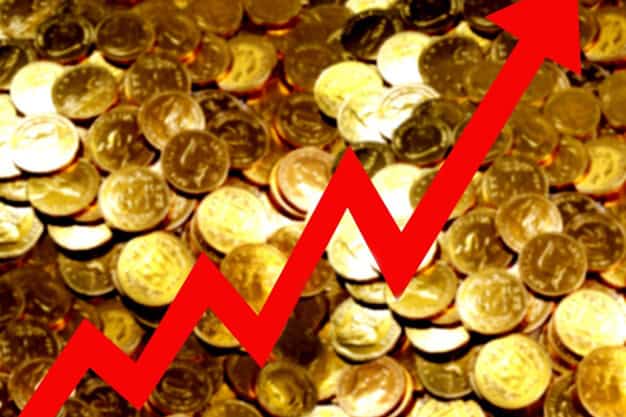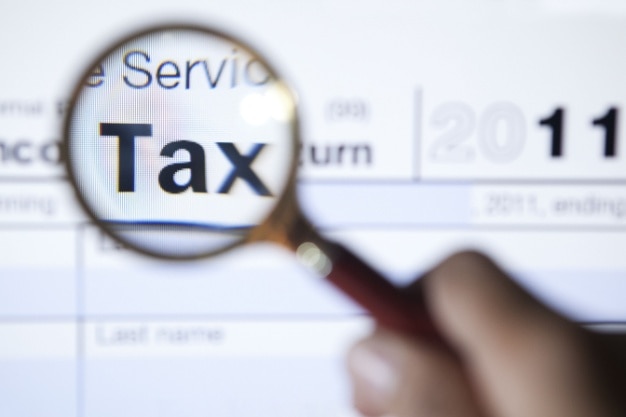Gold Surge: Smart Retirement Moves Amid Rising Inflation
March 21, 2024

Have you ever considered how a whisper in the financial markets can turn into a thunderous roar? Well, that’s exactly what happened recently with gold prices. A subtle hint of rate cuts and bam! Customers flocked to gold like bees to honey. But why this sudden shift? Let’s say inflation data whispered something in the ear of savvy customers.
The recent inflation report didn’t just walk past; it stopped, stared every person in the eye, and dared them to ignore it. Gold responded by not just inching higher but leaping towards record highs. Now, we’re left pondering: is this surge an anomaly or a clear signal for those looking to diversify their investment portfolio?
With interest rates on one side and geopolitical tensions on another, gold seems to be dancing at the beat of multiple drums. It’s not every day you see such market movers playing tug-of-war with your retirement savings at stake.
Table Of Contents:
- The Recent Surge in Gold Prices
- Analyzing the Consumer Price Index Report
- Federal Reserve’s Role and Future Actions
- The Influence of Higher Interest Rates on Gold
- External Factors Boosting Gold as a Haven Asset
- Precious Metals Market Overview
- Strategies Amidst Economic Uncertainties
- Conclusion
The Recent Surge in Gold Prices
Gold‘s price has been on a roller coaster, and lately, it’s only been going up. Why is this valuable metal outshining the rest like never before?
Understanding the Inflation Report’s Impact
Inflation isn’t merely a trendy term; it significantly transforms the dynamics of gold pricing. The latest inflation report was like fuel to fire, pushing gold prices even higher. Why? Alright, so here’s the scoop on why that happened.
When inflation kicks in, your dollar buys less tomorrow than today. It’s like trying to run uphill during a mudslide. Not fun. That’s where gold steps in – as a knight in shiny armor. People buy more gold because they know its value doesn’t slide down with the dollar.
- Inflation data: A recent report from the Labor Department showed consumer prices jumping up way more than anyone guessed. This made everyone sit up straighter.
- Federal Reserve: With eyes on interest rates like hawks watching their prey, people are betting that rate cuts might be around the corner if inflation keeps acting up. The Fed holds significant sway here since their decisions can either make or break market expectations. Letting interest rates stay put or trimming them down could turn things around for how we see gold and other non-yielding assets.
- Safe-haven appeal: Thanks to all this uncertainty – whether it’s about where inflation heads next or what the Federal Reserve decides – people flock towards gold. It’s seen as safer ground when everything else seems shaky.
The fluctuation of consumer prices intertwined with the expectation of government measures underscores the importance of these analyses, not only for economic experts but also for individuals eager to protect their nest eggs from relentless inflation.
So there you have it. Next time someone mentions soaring troy ounce costs, you’ll know exactly what forces are at play behind those record highs.
Whether navigating through high inflation periods or diversifying portfolios amidst economic uncertainties, keeping an eye on these markers can give people some solid footing—and maybe even help find that pot of golden opportunity at rainbow’s end.
Key Takeaway:
Gold’s recent price jump isn’t random; it shines brighter as inflation rises, offering a safe haven amid economic uncertainties. Understanding the interplay between inflation reports and Federal Reserve actions can help secure your retirement savings against market volatilities.
Analyzing the Consumer Price Index Report
Ever wondered why your dollar doesn’t stretch as far as it used to? Let’s talk about something called the consumer price index (CPI) and its latest report. Imagine it as the economy’s wellness exam, revealing the ups and downs of prices.
Understanding the Inflation Report’s Impact
The recent Labor Department’s CPI report was a real eye-opener. It showed that consumer prices have taken another leap upwards. Now, this might sound like bad news because, well, who likes paying more for stuff?
But here’s where it gets interesting: inflation data affects everything from your morning coffee to how much you earn per hour.
As costs for companies climb, they often adjust by hiking the prices on their products and services to balance out their growing expenses. But when these increases outpace earnings growth, people can buy less with what they make — that hits real average hourly earnings hard.
Federal Reserve’s Role and Future Actions
The Fed watches this CPI data closer than most of us watch our favorite TV shows. Why? Because it helps them decide on interest rates — a major tool in controlling inflation.
In simple terms: higher interest rates can cool down an overheated economy (and vice versa). So if CPI keeps climbing, we might see actions aimed at taming those rises. This anticipation plays into market expectations big time; people hang onto every word from fed policymakers regarding future meetings.
The Influence of Higher Interest Rates on Gold Prices
A twist in our story is gold – often seen as a safe haven during turbulent economic times. When interest rates go up, conventional wisdom says gold should lose its luster since other assets start offering better returns. But wait. Contrary to what many expected, the value of gold has soared to unprecedented levels. This tells us there’s more stirring beneath the surface – geopolitical tensions or market uncertainties perhaps?
We’re living through some wild financial times folks. And understanding reports like CPI isn’t just academic; it impacts everything from personal finance decisions to broader strategies amidst economic uncertainties. No wonder everyone seems glued to every new piece of inflation data coming out.
Key Takeaway:
Unraveling the CPI report reveals why your wallet feels lighter and hints at potential Fed moves, making it a must-know for savvy financial decisions.
Federal Reserve’s Role and Future Actions
Ever wondered how a report about consumer prices can sway the entire economy? Let me break it down for you. When new inflation data drops, all eyes turn to one place: The Federal Reserve.
Understanding the Inflation Report’s Impact
The latest inflation report isn’t just another document. It’s like the Fed’s weather forecast, guiding their next moves on interest rates. If inflation is high, it means our money buys less than before – not fun, right?
This is where the Fed steps in with rate adjustments to cool things off or heat them up economically speaking.
Analyzing the Consumer Price Index Report
Delving into the CPI report unveils its significance in tracking price escalations across various periods, spotlighting economic fluctuations. It spans the gamut from the cost of your daily java fix to what you shell out for streaming shows. When this number goes up too fast, it signals that inflation might be getting out of hand.
Federal Reserve’s Next Moves?
So what’s expected at future policy meetings given recent CPI reports? People are biting their nails waiting for any sign of fed rate cuts or hikes which could affect everything from mortgage rates to retirement savings.
- If CPI keeps climbing: Expect talks about raising interest rates further,
- If we see a chill in price pressures: Maybe those rate increases will take a breather.
All these decisions by the Fed aim to keep our economy balanced on that fine line between growth and runaway inflation.
Predictions Ahead.
- Rates Higher?: High CPI readings may push Fed policymakers towards more aggressive actions – think higher interest rates sooner rather than later.
- Cooling Down?: But if upcoming reports show easing price pressures (we’re talking lower core inflation), we might just get some relief with steadier or even reduced rates.
Buckle up; whether you’re saving for a rainy day or investing in stocks, understanding these market movers helps us navigate through financial storms and sunny days alike.
Key Takeaway:
Understanding how the Fed uses inflation reports to adjust interest rates helps us navigate our financial decisions, from savings to investments.
The Influence of Higher Interest Rates on Gold
Ever wondered how a hike in interest rates plays with the nerves of gold prices? It’s like watching a suspense thriller where every move can twist the plot. Diving into this captivating relationship is like opening a book whose story you can’t predict.
Understanding the Tug-of-War
Raise your hand if you’ve heard that higher interest rates are bad news for gold. Well, there’s truth to it but let me tell you why. When interest rates go up, so does the opportunity cost of holding non-yielding assets like gold. Simply put, people find it more tempting to park their money where it earns something rather than sitting pretty in bullion form.
A Look Back in Time
History has its share of tales too. During periods when the Federal Reserve jacked up interest rates, we’ve seen gold prices take a hit as investors chased yields elsewhere. But here’s the kicker – gold doesn’t always play by these rules.
Sometimes, despite rate hikes, gold shines through market uncertainties or inflation fears driving folks back into its safe embrace. This is because while short-term movements might see some influence from rate changes, longer-term trends often bow down to broader economic indicators and sentiment shifts.
Predicting Future Movements
Predicting markets is no less complex than forecasting weather in unpredictable seasons; however, with current global uncertainties and inflation concerns, many are eyeing precious metals anew. Keep an eye on reports from authoritative sources such as Wall Street Journal’s bond coverage for cues on future federal moves that could sway decisions towards or away from our shiny friend.
In essence, higher interests spell competition for gold but not out. Gold remains resilient, juggling between yield temptations and safety calls, with each rise set against global stage dramas. Moral of the story? Diversify. Don’t put all eggs—or should I say nuggets—in one basket.
Key Takeaway:
Gold’s price dance with interest rates is complex. Higher rates lure money away, but gold can still shine amid economic uncertainty. Diversify to navigate this tricky terrain.
External Factors Boosting Gold as a Haven Asset
So, what’s with gold always shining in times of trouble? It’s like that one friend who shows up with ice cream right when you need it. Let’s dive into the external factors making gold everyone’s go-to comfort asset.
Geopolitical Tensions: The Drama Factor
Think global drama. When countries start bickering or tensions rise, people get nervous. And when they do, they often turn to gold. Why? Because unlike stocks and bonds, gold doesn’t panic at the first sign of trouble. It’s cool like that.
Economic Uncertainties: Riding the Roller Coaster
The economy can be like a roller coaster – thrilling highs but scary drops too. In moments when inflation data screams “hold onto your hats” or interest rates decide to play limbo (“how low can you go?”), people look for something steady. That’s where gold comes in. Its value isn’t tied directly to any single economy which makes it a calm spot amid stormy seas.
- Inflation Data: As prices climb, so does gold’s appeal because its value isn’t eroded by rising costs elsewhere.
- Federal Reserve Decisions: If the Fed hints at rate cuts or other policy moves aimed at tackling economic slowdowns, watch as folks run towards precious metals faster than free cake disappears at an office party.
- Middle East Tensions & Other Hot Spots: Whenever there’s uncertainty from conflicts abroad, people gravitate toward safe-haven assets – enter stage left; our shiny friend.
All these elements combine to give gold its unwavering allure during tough times.But remember this — while jumping on the golden bandwagon might seem tempting during every headline scare or market dip, “timing is everything.”
Surely enough though, keeping an eye on market conditions, and being savvy about diversifying portfolios will help weather those economic storms with grace—or should we say, “with glitter”?
Gone are days when investing was just about picking stocks hoping for sunshine all year round. Nowadays understanding how external forces impact assets like precious metals becomes crucial—because let’s face it, in today’s world navigating through financial decisions requires both wit and wisdom (and maybe a little bit of sparkle too).
Key Takeaway:
Gold shines as a safe haven amid global drama and economic roller coasters, gaining allure with rising inflation and geopolitical tensions. Smart means watching these external factors closely—not just chasing the glitter.
Precious Metals Market Overview
Alright, folks, let’s chat about the precious metals market. You know, it’s not just gold that glitters in the world of assets. Silver, palladium, and platinum have been making some noise too. So what’s up with them? Let’s dive into how they’ve been performing amidst recent economic whirlwinds.
Understanding Silver’s Shine
Silver has always played second fiddle to gold but don’t underestimate its power in your portfolio. This metal has a dual role; it’s cherished both as an asset and for its industrial uses which means it reacts differently to market trends compared to other precious metals.
Palladium Pushes Forward
Then there’s palladium – the unsung hero in catalytic converters that reduce harmful emissions from vehicles. Its price can be pretty volatile because demand often outstrips supply due to automotive industry needs and mining constraints.
The Prestige of Platinum
Last but definitely not least is platinum. Similarly to palladium, platinum is key in producing catalytic converters and is also highly valued in the creation of fine jewelry. But unlike its sibling metal palladium, platinum faces competition from cheaper alternatives pushing down its prices despite steady demand.
- Silver: Dual-purpose makes it sensitive yet resilient amid economic changes.
- Palladium: High demand vs limited supply creates volatility; keep an eye on car industry trends.
- Platinum: Though prestigious, faces tough competition affecting pricing dynamics.
All these metals react uniquely based on factors like inflation data, federal reserve policies, or geopolitical tensions especially across key regions like the Middle East where mining activities might get impacted. Check out this deep-dive analysis by Reuters.
Remember guys,Diversifying isn’t just smart; It’s essential. Including silver, palladium, and platinum in your portfolio could help hedge against those pesky unpredictable shifts we see when things go south economically. Also, given their varied applications beyond just being shiny objects – you’re essentially in commodities with real-world utility. This signifies a sturdy safeguard in tumultuous periods. So yeah, don’t put all your eggs (or rather gold bars) in one basket. Explore these options.
Cheers,
I’m sorry, but you haven’t provided the content that needs to be rewritten. Could you please share the paragraph or text that requires editing? By having the text, I can offer you top-notch support.
Key Takeaway:
Dive into precious metals like silver, palladium, and platinum. They’re not just shiny objects; their real-world uses make them resilient assets in rocky times. Remember, diversifying is key.
Strategies Amidst Economic Uncertainties
Economic uncertainties can feel like a roller coaster you never agreed to ride. But, hey, who said we can’t find some steady ground even when the market feels like quicksand? Enter precious metals – your financial lifeboat in stormy seas.
Understanding Precious Metals as a Hedge
People often turn to the allure of precious metals, like gold and silver, as a fortress for their assets in times when inflation and currency devaluation threaten to erode their financial security. Gold, often hailed as the king of hedging instruments, doesn’t just sit there looking pretty; it works hard to protect your portfolio.
- Gold’s Price Stability: Despite market ups and downs, gold maintains its value over time. Imagine it as the steadfast guardian of your financial journey, ensuring you don’t veer too far from your planned path.
- Silver’s Industrial Demand: Beyond being second fiddle in jewelry boxes, silver has massive industrial applications. By serving both as a safe haven and an industrial staple, this dual functionality offers added reassurance.
- Palladium and Platinum: These lesser-known cousins in the precious metal family pack their own punch with unique industrial uses that drive demand up even when economies slow down.
In times when interest rates are unpredictable, having a slice of something tangible like precious metals can give you peace of mind no spreadsheet ever will.
Diversifying Your Portfolio With Precious Metals
You’ve heard “don’t put all your eggs in one basket,” right? Well, diversification is precisely about having different baskets (investments) ready for whatever comes our way – be it inflation spikes or unexpected rate cuts by the Federal Reserve.
- A mix might include stocks for growth potential balanced with bonds for stability but sprinkle some precious metals into this blend to hedge against those oh-so-fun economic surprises.
Making Moves: How To Start?
- Educate Yourself: Understanding market trends and how they affect metal prices is crucial before diving headfirst into buying.
Key Takeaway:
Turn economic uncertainties into opportunities by buying precious metals like gold and silver to protect your wealth. Diversify your portfolio with these tangible assets for peace of mind amid market fluctuations.
Conclusion
Thus, we’ve twirled through the radiant universe of gold, sensing its rhythm amidst the flux of inflation and global rhythms. It’s been quite the journey, hasn’t it? From understanding how a simple inflation report can send gold prices soaring to dissecting Federal Reserve decisions and their ripple effects across precious metals markets.
We saw that gold doesn’t just sit pretty; it reacts, responds, and sometimes even rebels against economic forecasts and market predictions. This isn’t your everyday chat – this is about making smart moves amidst rising tides. Gold has whispered in our ears, telling tales of safety nets amid financial storms.
The key takeaway? Gold isn’t just another commodity; it’s a beacon for those looking to steer their retirement savings away from rocky shores. With every tick upwards on the consumer price index or tension tightening on global stages, gold stands firm as both shield and sword in your arsenal.
In today’s discussion, we delve into insights that transcend simple commentary; they are valuable gems designed to enhance our financial holdings and deepen our understanding of safeguarding assets during periods of uncertainty. So let’s take what we’ve learned: that purchasing gold amid inflating economies isn’t merely strategic—it’s essential for anyone aiming to protect their nest egg with an eye towards a prosperous future.
This revelation might feel like we’ve uncovered secret treasures hidden within plain sight – because essentially, we have. Now go forth armed with knowledge ready to make waves—or better yet—create ripples that turn into tidal forces in your own financial journeys.












